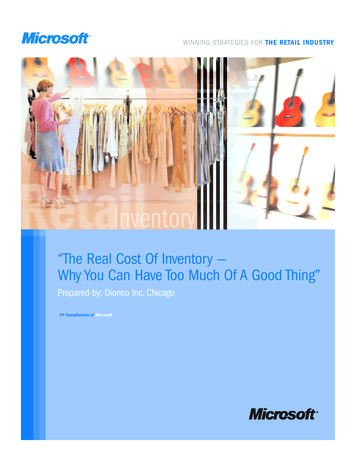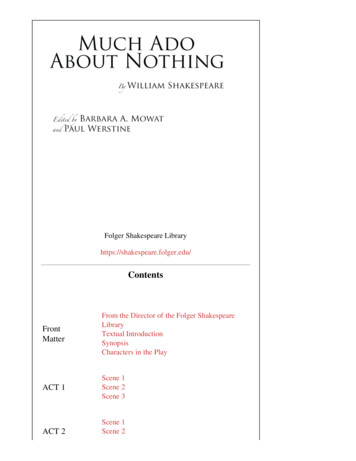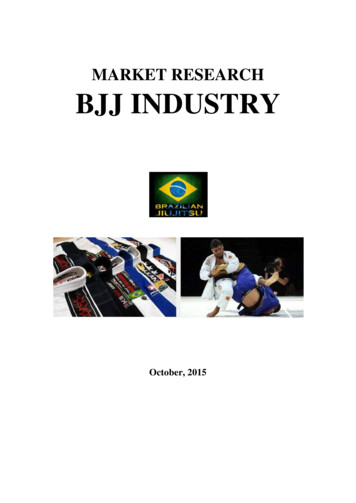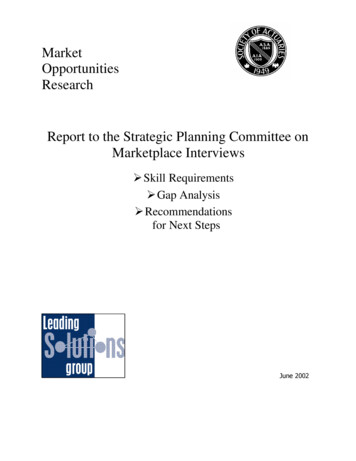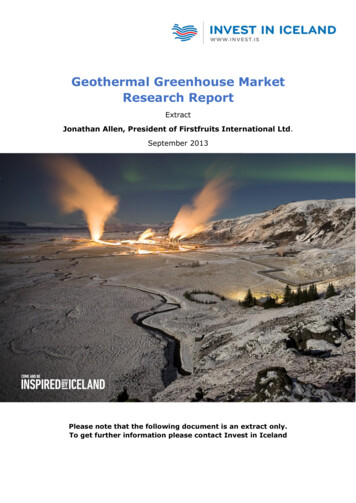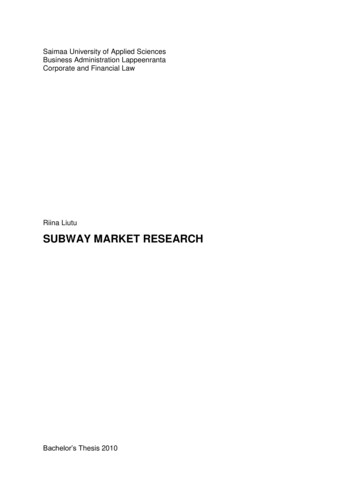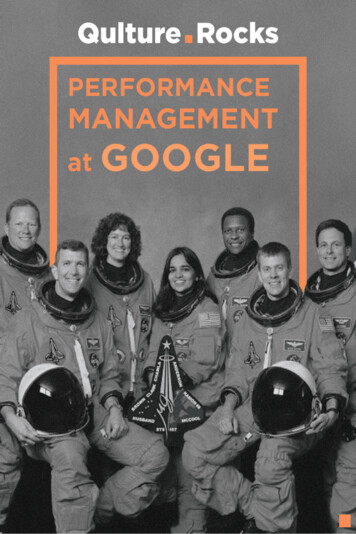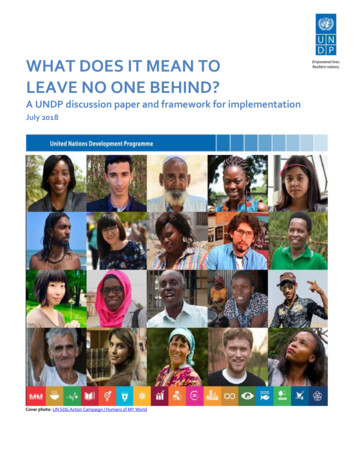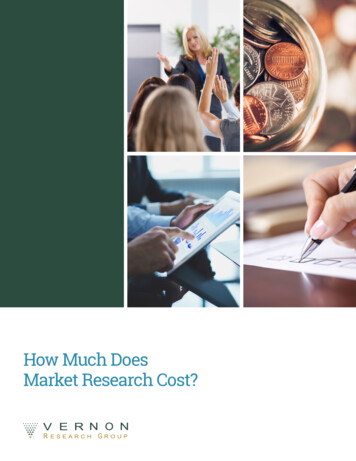
Transcription
How Much DoesMarket Research Cost?
TABLE OF CONTENTSIntroduction.3Value of Market Research.4Determining Your Research Costs.5COST FACTOR 1Research Methodology.6Research Methodology - Secondary Research.7Research Methodology - Qualitative Research.8Research Methodology - Quantitative Research.9Research Methodology - Masked or Not Masked?. 11COST FACTOR 2Sample Size. 12COST FACTORS 3 & 4Incidence Rates & Data Collection Method/Participant Incentives. 14Ways You Can Reduce Research Costs. 16Okay, Let’s Talk Dollars. 18
Attempting to put a price tag on market research is like trying to answer thequestion, “What does a vacation cost?” It depends on which direction youwant to go, who will be involved and what you want to accomplish. Thereare too many variables that affect the cost of market research to provide aone-price-fits-all figure. It is possible, however, to examine how those factorsimpact the cost of market research, so you can get a clearer idea of yourpotential investment. Then, you can decide if you should backpack it or gofirst-class.3HOW MUCH DOES MARKET RESEARCH COST?SHARE THIS EBOOK
Value of Market ResearchFirst, it is important to establish the value of conducting market research. Why invest in thiskind of research at all? History has shown that organizations that assume they know theirmarkets or customers without validating these assumptions are often blindsided by mistakesor missed opportunities.What happened with 3-D television is a sobering example. The assumption was made thatthe technology which was successful on theater screens would be popular in consumers’homes. Products were rushed to market without much research. That assumption didn’tpan out as consumers balked at the expensive 3-D sets, extra required equipment, technicalproblems such as eye strain and a limited viewing area, and a lack of 3-D programming.Demand for the product was weak and the launch failed.When it comes to major business initiatives like new product development, branding,advertising campaigns and market expansions, you’re smart to base your critical decisionson valid, current data. Market research provides a solid base of objective data to work with,and, if you pick the right market research firm, sound analysis for building or retooling yourbusiness strategy.With most industries moving to a “customer to business” model, understandingcustomers and prospects is more valuable and necessary than ever. At thesame time, the automation of many business functions is producing greatervolumes of data. In fact, a report by IBM shows that CMOs continue tofeel overwhelmed by the massive amounts of raw data they have access toevery day.71%20132011OVERWHELMED:More CMOs now feel underprepared for the data ket research can help you harness the information that big data has unleashed. Theability to extract meaningful information from big data, give it context and identify thedrivers behind the behaviors and relationships uncovered in analytics is essential to justifythe expenditure of major capital and new business ventures. Market research allows you toreveal powerful influences that may green-light your new initiatives or proactively pull theplug on risky ventures.4HOW MUCH DOES MARKET RESEARCH COST?SHARE THIS EBOOK
Determining Your Market Research CostsProviding price ranges for market research is challenging because of the wide range ofresearch services and methodologies available today. Distilling down to the most basic level,there are four main factors that influence your market research costs: Type of research appropriate for your research goals and costs associated with it(labor, travel, etc.) Sample size (number of participants you need/want in the research) Incidence rate (the percentage of people in the general population or businesspopulation who meet your criteria for being in the research) Data collection method and incentives needed to gain participation in theresearchEach project is unique. However, with planning and a little creativity, a custom marketresearch package is available for nearly every budget.Let’s take a deeper look at the factors involved in calculating yourpotential market research costs.5HOW MUCH DOES MARKET RESEARCH COST?SHARE THIS EBOOK
COST FACTOR 1:Research MethodologyThe cost of your research is closely related to the type of research you need. To determinewhat methodology is needed, ask yourself these questions: What business goal(s) are you trying to achieve?What business decision(s) do you need to make?What audience are you trying to reach (who influences purchase decisions)?What level of insight do you need – broad or very specific?How quickly do you need the information?What is your budget for the project?What data or information do you already have that is relevant to the research?The answers to these questions will help you determine if you need secondary, qualitative orquantitative market research or some combination. The answers will also indicate what typeof analysis is appropriate, what sample size is needed and what data collection challengesyou may encounter.If you don’t know much about the potential buyer, market demand or the topic of theresearch, you will likely require secondary or qualitative research followed by quantitativeresearch. If you have some knowledge of the market or buyer, but need additional data orwant to validate that your knowledge is true industry- or market-wide, you may be able tomove forward with quantitative research only.The type of findings you are interested in also determines research methodology. If youwant to explore ideas and concepts or observe behaviors, qualitative research is most likelyneeded. On the other hand, if you need precise data on specific questions, quantitativeresearch is best.The depth and scope of the study will have a significant effect on the budget you’ll need toachieve your goal.6HOW MUCH DOES MARKET RESEARCH COST?SHARE THIS EBOOK
Research Methodology –Secondary ResearchSecondary research is simply accessing and analyzing information already gathered. Sourcesinclude published market research reports, company/organizational websites, academicstudies, publication articles, U.S. Census data, various association reports and other externalsources. It also includes existing data within your company, such as prior sales reports,accounting records and customer data (big data).You can conduct this research on your own or hire a firm to assist. Secondary researchis often a key step if you are looking at the market demand and competitive landscapewith regard to starting a new company, entering a new market or niche, opening up a newlocation or developing a new product or service. Secondary research can also reveal certainfindings you can test or probe further in the primary research. For example, you may findin your customer data that sales decline after a customer has been buying for a year – yourresearch can identify the reasons why. Reviewing secondary research first will identifyquestions you can confirm with your own sample, as well as questions you can eliminatefrom the research (opening up the opportunity to ask other questions).7HOW MUCH DOES MARKET RESEARCH COST?SHARE THIS EBOOK
Research Methodology –Qualitative ResearchQualitative research methods are exploratory, ideal for applications such as concept testing,discussing user needs or testing marketing concepts. Qualitative research is useful whenyou don’t know what to expect, to help you define a problem or opportunity or to developan approach to a problem. You also can also use it to dive deeper into issues and explainnuances related to a concept or problem. Common data collection methods are focusgroups, triads, dyads and in-depth interviews, which can be conducted in-person, via phoneor online. Shop-alongs, in-home interviews and consumer observations (ethnography) arealso in the qualitative toolbox. Businesses often use qualitative research for subjective topics.Common uses for qualitative market research are: Generating new product ideas or direction for research and development effortsInvestigating positioning and marketing strategyIdentifying product or brand strengths and weaknessesInvestigating purchase decision dynamicsExploring the impact of branding and ad campaignsExamining perceptions in market segments, such as demographic and customergroups Studying emotions and attitudes about social and political issues Validating assumptions regarding questions and potential responses prior todeveloping a quantitative survey8HOW MUCH DOES MARKET RESEARCH COST?SHARE THIS EBOOK
Research Methodology –Quantitative ResearchQuantitative research methods are used to obtain objective data produced through asystematic process not subject to interpretation. Quantitative research includes datacollected through surveys (online, phone, paper), audits, points of purchase (purchasetransactions) and click-streams. Quantitative market research generally includes a largesample size so that the data can be aggregated and quantified, allowing researchers to drawconclusions that are projectable to a larger audience. Sometimes done in conjunction withqualitative research, quantitative market research covers areas such as: Brand measurement and positioningAdvertisement or message testingProduct/service/business concept testingDetermining adoption of new products/services and the ideal bundle of featuresCustomer satisfaction and loyaltyMarket segmentation and customer profilesPricing researchMarket feasibility, competitive analysis, share preference and demand forecastingEmployee engagement and satisfaction9HOW MUCH DOES MARKET RESEARCH COST?SHARE THIS EBOOK
RESEARCHMETHODS BEST USED FOR PROBABLY NOT SUITED FOR QUALITATIVE When key objectives/parametersare not entirely clear Statistically projectable results Identifying full range ofresponses/opinions Segmentation of results bydemographic or psychographicdata Brainstorming new concepts forfurther testing Determining concrete product/service variables, such as price Simulating a tactile experience Observing behaviors Probing opinionsQUANTITATIVE Predicting behaviors or affinitiesacross populations Modeling based on demographiccharacteristics Creating market simulations thatmodel/predict purchase behaviors10 Exploring a little understoodsubject or revolutionary product/service Testing a product that requireshands-on interactionHOW MUCH DOES MARKET RESEARCH COST?SHARE THIS EBOOK
Research Methodology –Masked or Not Masked?An important part of the research methodology for any study is whether it should beconducted masked or not. A masked study means that the participants do not know whichcompany or organization is sponsoring the study and getting the results – it is presentedto them as a consumer, industry or community study. In a non-masked study, participantsknow who is conducting the study or paying the research firm to conduct it. In many cases,non-masked studies experience easier and quicker data collection, higher response rates andrequire less or no incentive. Of course, conducting a study non-masked introduces potentialbias into the results, so research factors, not cost factors, should dictate this decision. Forexample, a customer satisfaction study can often be conducted non-masked and with noincentive, while a brand study typically is conducted masked.11HOW MUCH DOES MARKET RESEARCH COST?SHARE THIS EBOOK
COST FACTOR 2:Sample SizeHow many people you need in your study is mostly determined by two factors: how youintend to use the research results and what sample margin of error you can accept (thesetwo are interrelated). Will you make a critical business decision based on the researchfindings or are you trying to better understand your customers so you can tweak yourmarketing message? The more critical the decision, the more important it is that yourresearch is scientifically valid, which requires a larger quantitative sample. In general, themore participants you have in your research, the more confident you can be that your resultsare not due to chance and can be projected over the entire population of similar people.Examples of critical decisions include: Opening a new location or entering a new market or industry Developing a new product or service that would require hiring or trainingemployees, investing in new materials/marketing or equipment or retooling Setting a new price for products or services, which will have a direct impact onrevenue and market share Developing a new brand or upgrading an old one, which will have to compete in themarket and require new materials and marketing Utilizing research results to make improvements or changes in operations, businesspolicies or processes or staff trainingOn the other hand, if you want to obtain feedback on potential product promotions or gaininsights to fuel the early stages of product development, you can probably accept a highermargin of error for your results. For these purposes, you can use a smaller sample, like youtypically have for focus groups, shopper intercepts or individual interviews. In some cases,you can forego market research and test out in the market – for example, online or so
same time, the automation of many business functions is producing greater volumes of data. In fact, a report by IBM shows that CMOs continue to feel overwhelmed by the massive amounts of raw data they have access to every day. OVERWHELMED: More CMOs now feel underprepared for the data explosion. 2011 2013 Felt underprepared Felt 71% underprepared 82% Market research can help you harness

